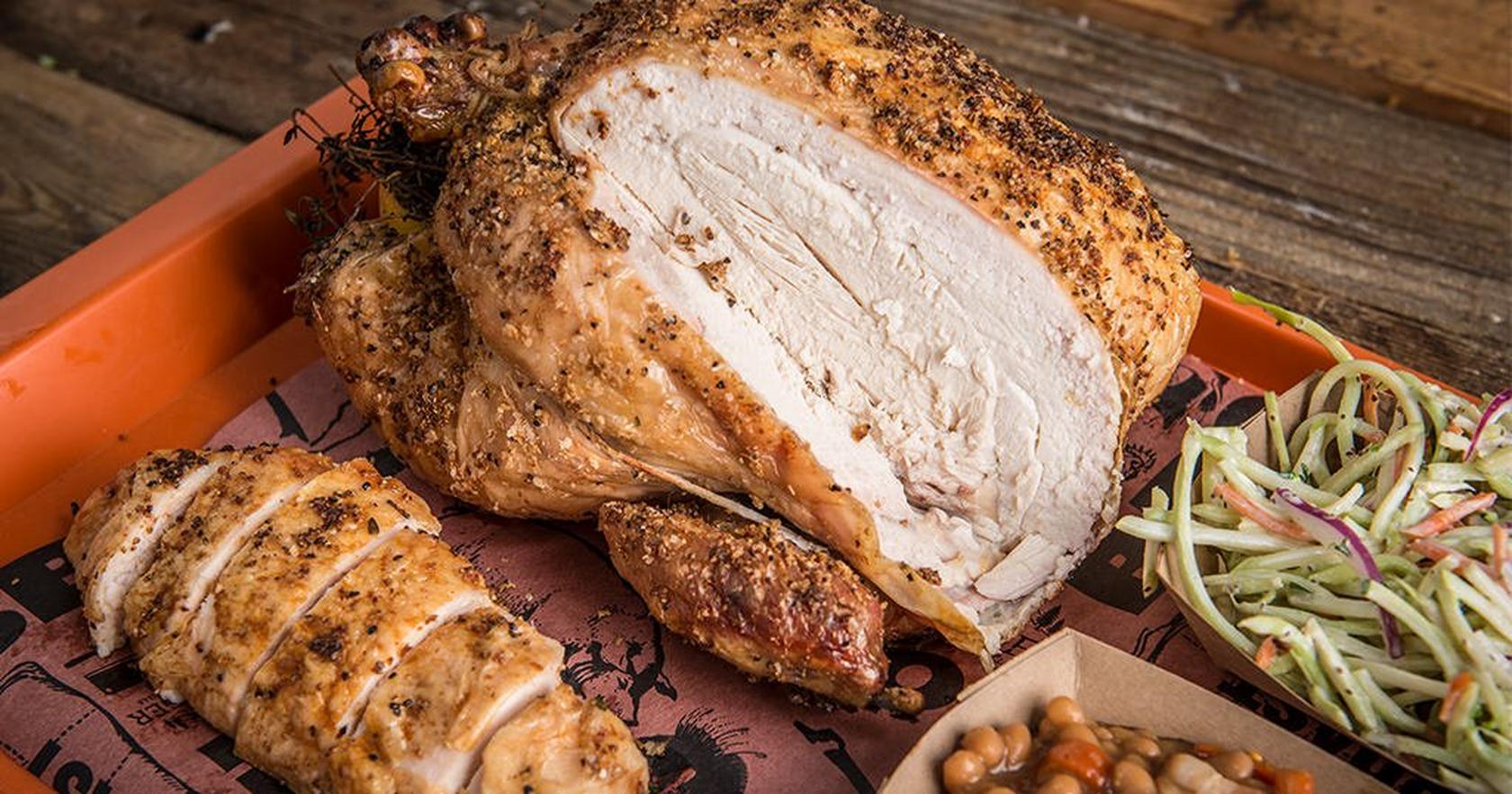
There’s no half-assing when it comes to smoking a whole chicken, but with only three essential steps to follow, anyone (even beginner grillers) can get the hang of it. Once you know how to smoke a whole chicken, you’ll want to challenge yourself to experiment with rubs, and brines.
Poultry can be daunting because undercooked chicken isn’t safe to eat, but at the same time, you don’t want to overdo it. According to a Traeger expert, one of the most common fears people have is “Overcooking. Always go to 165 degrees Fahrenheit internal temperature. Chicken can freak people out but a properly cooked chicken is safe to serve once internal temp hits 165. (Cooking to this temperature) will ensure it stays moist."
At the same time, you may want to consider a higher temperature than is traditionally called for in smoking. "I never cook my chicken under 325 degrees because the skin tends to get a little rubbery," says Curtis Nations, a grilling instructor and BBQ champion.
Read on for the tools and guidelines that will help you smoke a whole chicken like a pro.
How to Choose a Chicken for Smoking
Good barbecue begins with good meat, and ensuring your chicken is healthy and fresh makes all the difference.
Of course, in a perfect world, you’d get it fresh from the farm, but you can get good meat at your local butcher shop or grocery store if you know what to look for when buying chicken.
-
The skin should appear white and milky -- this is the sign of a bird raised on quality grain and in a healthy environment. If you see discolored skin, it could mean the bird isn’t fresh, wasn’t packaged properly, or wasn't raised well.
-
Blood spots are also a bad sign -- this suggests that the bird endured excessive stress and the meat will be tough.
-
Look for meat that has not been injected or marinated to make it look fresh. You want full control over the marinating process so that you can flavor it exactly how you like it. Also, you'll know what ingredients will end up on your family and guests' dinner plates.
How to Prepare a Chicken for Smoking
Smoking a whole chicken can take as little as an hour and change including prep time. The three essential steps are:
- Wash the bird
- Prepare the bird based on your preferred cooking method
- Season it
- Smoke it
How to Spatchcock a Chicken
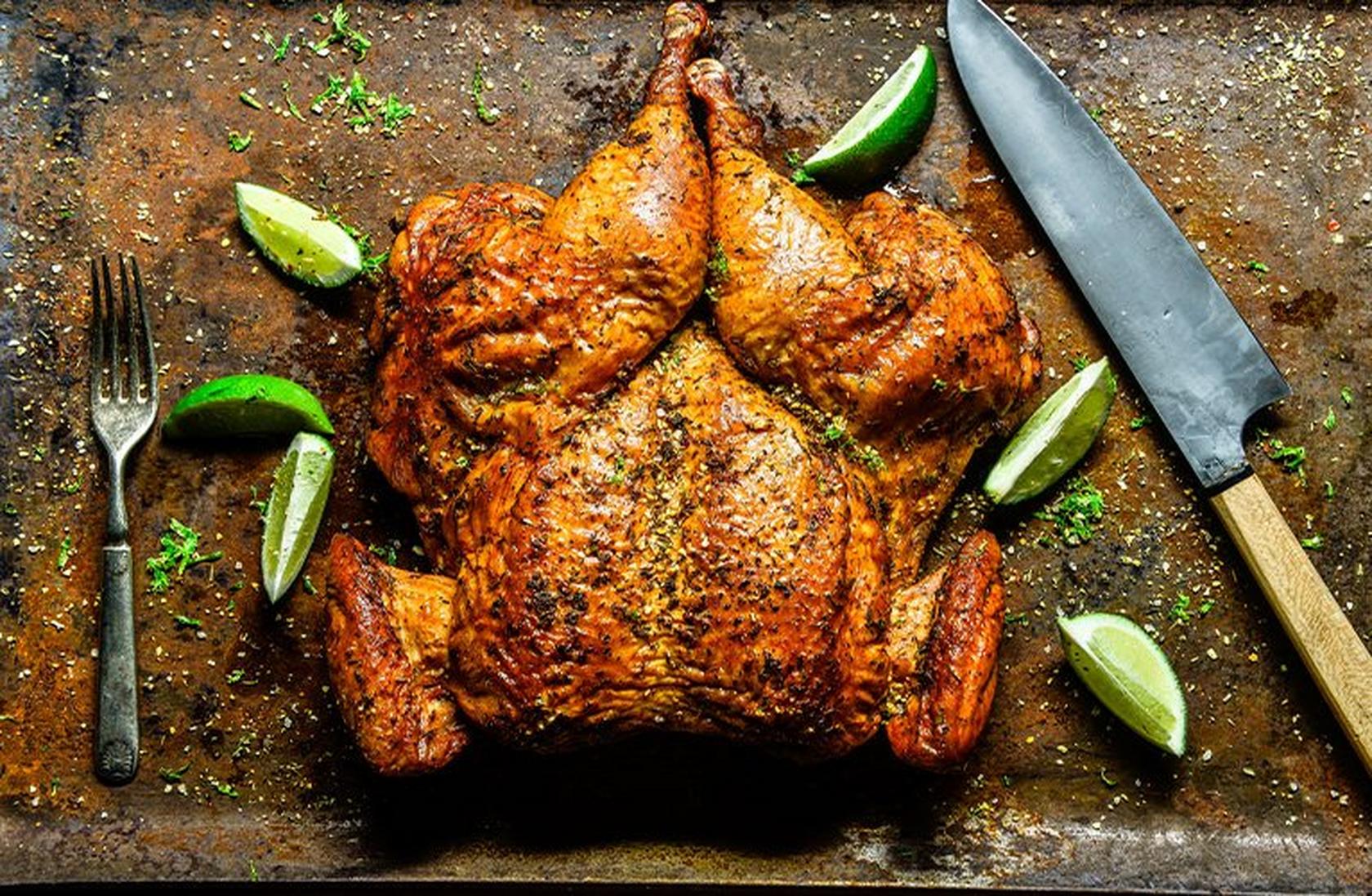
Spatchcocking a chicken is removing the backbone of the bird so that it can lay flat in a pan or grill. A spatchcocked chicken will usually cook more evenly, and in a shorter period of time. Our Traeger experts recommend spatchcocking as the best way to smoke a whole chicken.
This expert tutorial has all the information you need to spatchcock at home.
The basic process simply involves using a large knife to cut on either side of the backbone, through the ribs, then discarding it. Once the backbone is gone, you split the breastbone, allowing you to spread the bird flat. This recipe for Spatchcock Chile-Lime Chicken is an example of how spatchcocking can save you time — it cooks in just 40 minutes!
Beer Can Chicken Method
The beer can chicken method of smoking a whole chicken is something every grillmaster should try once. It makes for a very tender bird, as the evaporation from the beer helps keep the meat from drying out.
We like the beer can method so much, we built a special Chicken Throne to make it easier. This sturdy ceramic stand will keep your chicken from tipping over, and protect the meat from any toxins that the can could release.
Follow our beer can chicken recipe to get tender meat and smoke flavor like you've never had before.
Smoked Chicken Rub & Seasoning
A dry rub can boost your smoked chicken's flavor and appearance. Most chicken rubs include salt, which enhances flavor, and a colorful element like paprika, chile powder, or cumin to help pale chicken skin look more appetizing when it crisps up.
At Traeger, we offer a selection of premade rubs that top grillmasters swear by. Here are three they recommend for whole chicken.
Traeger Chicken Rub: Citrus and black pepper flavor profile. Pairs well with cherry hardwood pellets.
Traeger Pork & Poultry Rub: Apple and honey flavor profile. Pairs well with apple hardwood pellets.
Traeger Rub: Oregano and basil flavor profile. Pairs well with hickory hardwood pellets.
Smoked Chicken Brine
In order to ensure your meat is flavorful to the bone, try out a good brine. Brining increases salt absorption into the meat, according to Traeger Pro Doug Schieding, who cooked the winning chicken at the 2015 Houston Livestock and Rodeo BBQ Contest.
Brining your bird is the best way to infuse flavor deep into the meat. No matter how much salt you use, a dry rub will only penetrate so far into the meat, but submerging your bird in brine pulls salt and flavor into the muscles -- and keeps it there throughout the cooking process.
"I use a brine to impart moisture in my poultry," says Traeger Pro Matt Pittman. "I keep it simple with an old school salt brine. You can use 1/2 cup salt and sugar plus a tablespoon of your favorite BBQ sauce mixed in a gallon of water."
A basic brine is ½ cup of salt (or 1 cup of kosher salt) for every gallon of liquid. You’ll need enough liquid to fully submerge your chicken. Many people — like Matt — use sugar to balance the salty flavor, and this also helps caramelize the skin, giving it an appetizing brown color.
You don’t have to use only water for the liquid. It's a lot of fun to experiment with broths, juices, beers, and more to change up the flavor. Just be wary of salt and sugar content if you’re working with juices or cooking wines. You’ll want to adjust your dry ingredients accordingly.
You can also add all sorts of herbs, vegetables, and spices to your brine to infuse even more flavor into your meat.
Traeger Pro Doug Scheiding offers this brine, which he used in a barbeque competition:
- 1 gallon distilled water (divided)
- 1/2 cup kosher salt
- 1/2 cup Tony Chachere's Creole Seasoning
- 1/2 cup applewood-smoked salt
- 2 cups brown sugar
- 16 oz. orange juice concentrate
- 8 whole peeled garlic cloves (smashed or crushed with a knife)
- 4 tbsp. sage (put in after boiling)
Garlic, lemon, apple, rosemary, thyme, carrots, onions, celery, and sage are all commonly used in poultry brines, but the list doesn’t stop there.
For example, if you’re going for spicy, adding hot peppers to the brine is going to give your meat a kick. Don’t overdo it with the hot peppers, one or two fresh chiles including the seeds is more than enough for an hour brine, you might want to do even less for an overnight brine.
Check out our poultry brining kit.
How Long Should I Brine Chicken?
Ideally, you’ll let your bird brine overnight in the fridge, but even letting it brine for an hour will make a noticeable difference in flavor. The longer it brines, the more salty it gets, which is why we don’t recommend brining for over 24 hours. Brining for too long results in oversalted meat.
Smoked Chicken Injection
You can also inject the brine into your chicken. Traeger Pro Doug Scheiding says: "I used to be a chicken briner but now am an injector."
Injecting brine is "easier and (adds) much more flavor deeper into the meat," he says. Injection is a mixture of phosphates (salt on steroids) and flavor from dissolved seasonings. It adds about 10-17% moisture to chicken.
If you want to start out simple, Doug recommends chicken broth. If you're ready to go with a more advanced brine — like the one Scheiding used to win Grand Champion at the Houston Livestock Show and Rodeo — try this Traeger chicken injection recipe.
How to Dry Brine Chicken
Another technique recommended by Doug Scheiding is dry-brining. This involves salting the chicken, then letting it sit in the refrigerator while the salt is absorbed. "Basically the salt on the skin dissolves and moves into the skin," says Doug. "This helps give it more bite through or perhaps even crispiness depending on how it is cooked."
Doug describes this technique in his Traeger beef ribs recipe. The same steps will work well for chicken, too.
Smoking Chicken on a Pellet Grill
Smoking a whole chicken on a pellet grill is as easy as cooking in an oven. In a pellet grill, which uses wood pellets as a source of fuel, your bird will be infused with smoke flavor.
What’s the best wood for smoked chicken? Most pair well with poultry, so let your other flavors guide you. If you need to add sweetness, any fruit tree or maple will help. If you want bold flavor try hickory or mesquite, and if you’re just not sure, feel free to try a premade blend.
Doug's opinion? "For chicken, fish, and turkey it is always apple."
After you choose your smoke flavor, set the pellet grill to 225 degrees Fahrenheit, or the Super Smoke setting on your Traeger. Preheat with the lid closed for 15 minutes. Remove chicken from the brine (if used) and pat dry.
Place the whole chicken in your Traeger and cook at it at 225 degrees Fahrenheit for 45-60 minutes. This low and slow start will let the smoke flavor penetrate the bird.
Then, increase the temperature of your Traeger to 350 degrees Fahrenheit. The higher heat will help render out the skin of the bird so it isn't as rubbery. Roast until the internal temperature of the bird (as measured at the thickest part of the breast) is 165 degrees Fahrenheit.
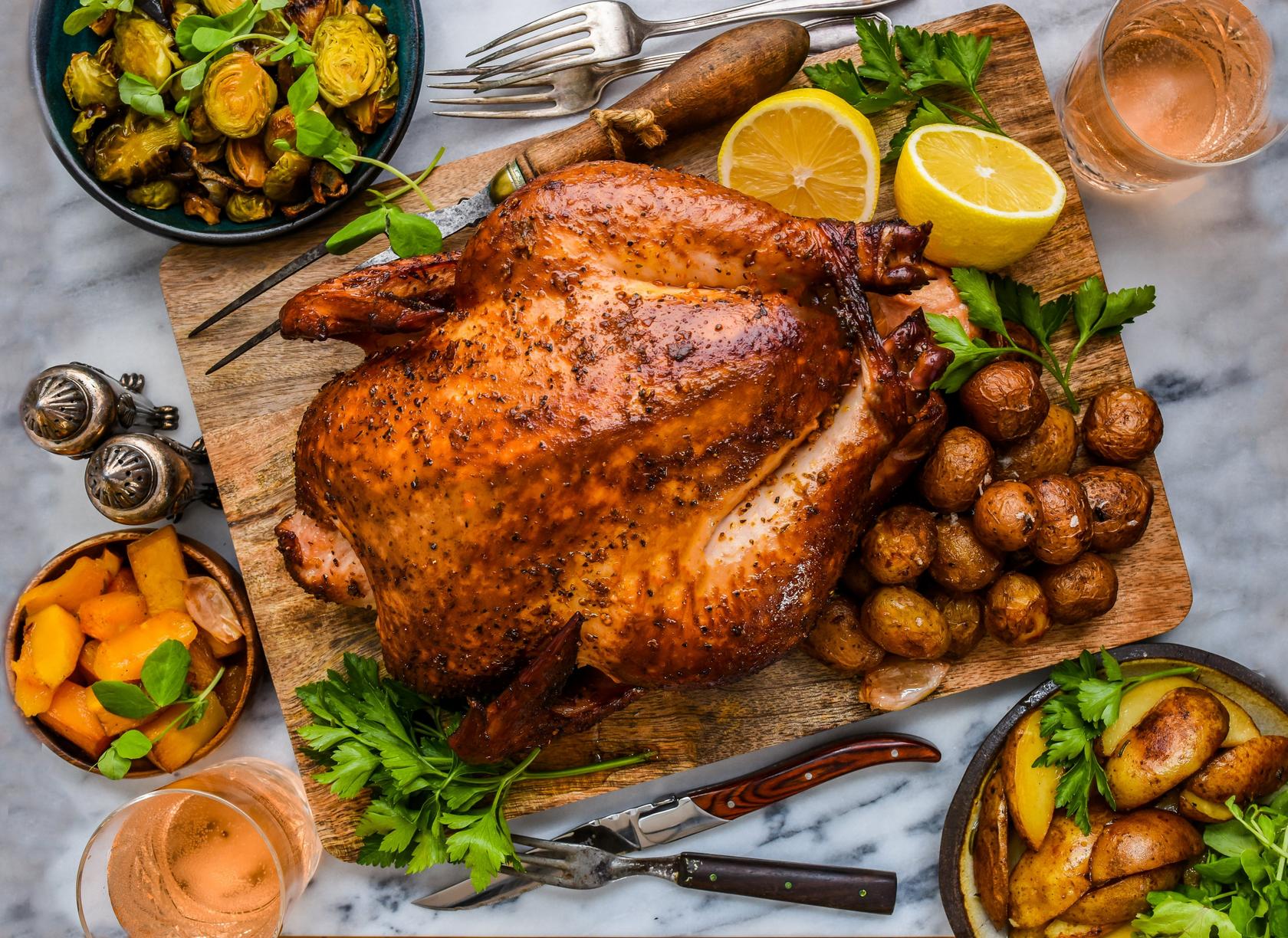
How Long to Smoke a Whole Chicken
The cooking time for a smoked whole chicken will depend on how you've prepared it, the temperature you've set, and the final product you're looking for. The method above will give your bird a smoky flavor, but may not result in crispy skin if not roasted at a higher temperature. "The higher the temperature, the crispier the skin," says Matt Pittman of Meat Church BBQ.
Spatchcocked Chicken: 400 degrees F for 40-50 minutes, or until internal temperature reaches 165 degrees F. See recipe.
Beer Can Chicken: 350 degrees F for 60-75 minutes, or until internal temperature reaches 165 degrees F. See recipe.
Whole Chicken: 375 degrees F for about 60 minutes, or until internal temperature reaches 165 degrees F. See recipe
To measure the temperature of a whole chicken, insert a MEATER digital thermometer into the thickest part of the breast. The chicken is ready to take off the grill when the temperature reaches 165 degrees F.
Reheating Smoked Chicken
To reheat, it’s perfectly fine to leave meat on the bone. Create a tent of tin foil to cover your smoked chicken, and before closing it, add a tablespoon of water. This will create steam inside the foil that cooks the meat quickly while moistening it.
Heat your oven or pellet grill to 325 degrees and cook until the internal temperature reaches 165 degrees.
If you’re eager to use or discard the carcass you can use shredded chicken in all kinds of recipes. Just be wary of overcooking it. Typically, you’ll want to make sure the vegetables are done or close to done before adding precooked meat.
Leftover Smoked Chicken Recipes
The flavor of smoked chicken is unique, and the leftovers make an irresistible topping for pizza, salads, sandwiches, and more. Or, you can give your leftover smoked chicken a new home in these tasty recipes.
White Chicken Chili Recipe
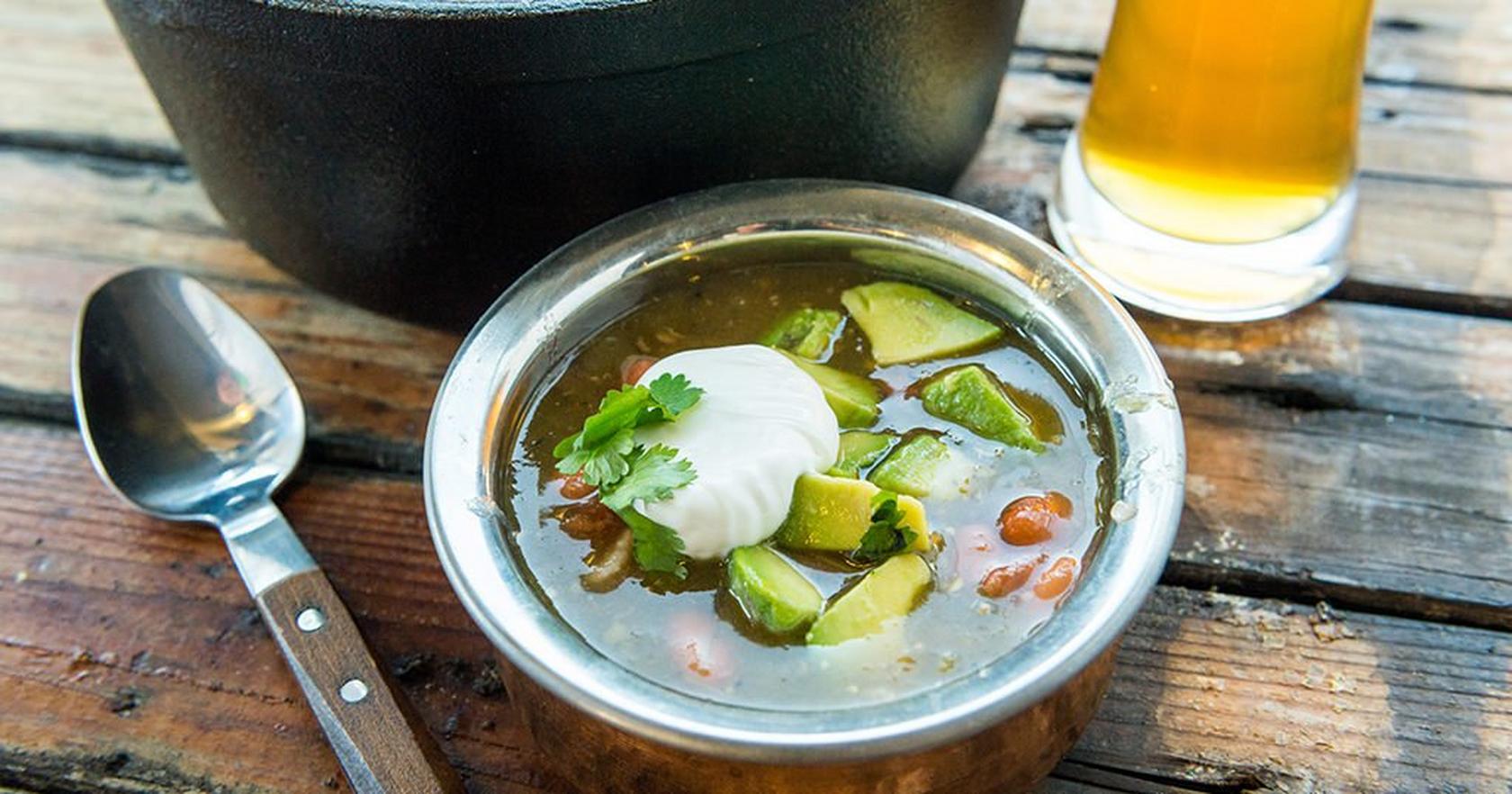
This White Chicken Chili recipe is a warm and cozy option for leftover chicken. And it's incredibly easy. Just add chicken broth, leftover chicken, white beans, salsa, cumin, onion powder, garlic powder, and salt/pepper to taste to an oven-safe pot. Bake in your oven (or Traeger grill) at 400 degrees Fahrenheit for four hours.
Pour into bowls and top with avocado, sour cream, and chopped cilantro.
Smoked Chicken Salad Sandwich
This spicy chicken salad recipe calls for brining, then smoking chicken, but you can just use your leftover chicken instead of cooking a new batch.
Dice the chicken and add chopped red bell pepper, green bell pepper, scallions, and pickled jalapeño peppers. Then make a dressing by whisking together the mayonnaise, lime juice, cumin, black pepper, and garlic salt. Stir in the cilantro, then stir the chicken mixture in with the dressing. You can make this ahead and chill it for up to 3 days.
Loaded Grilled Chicken Tacos
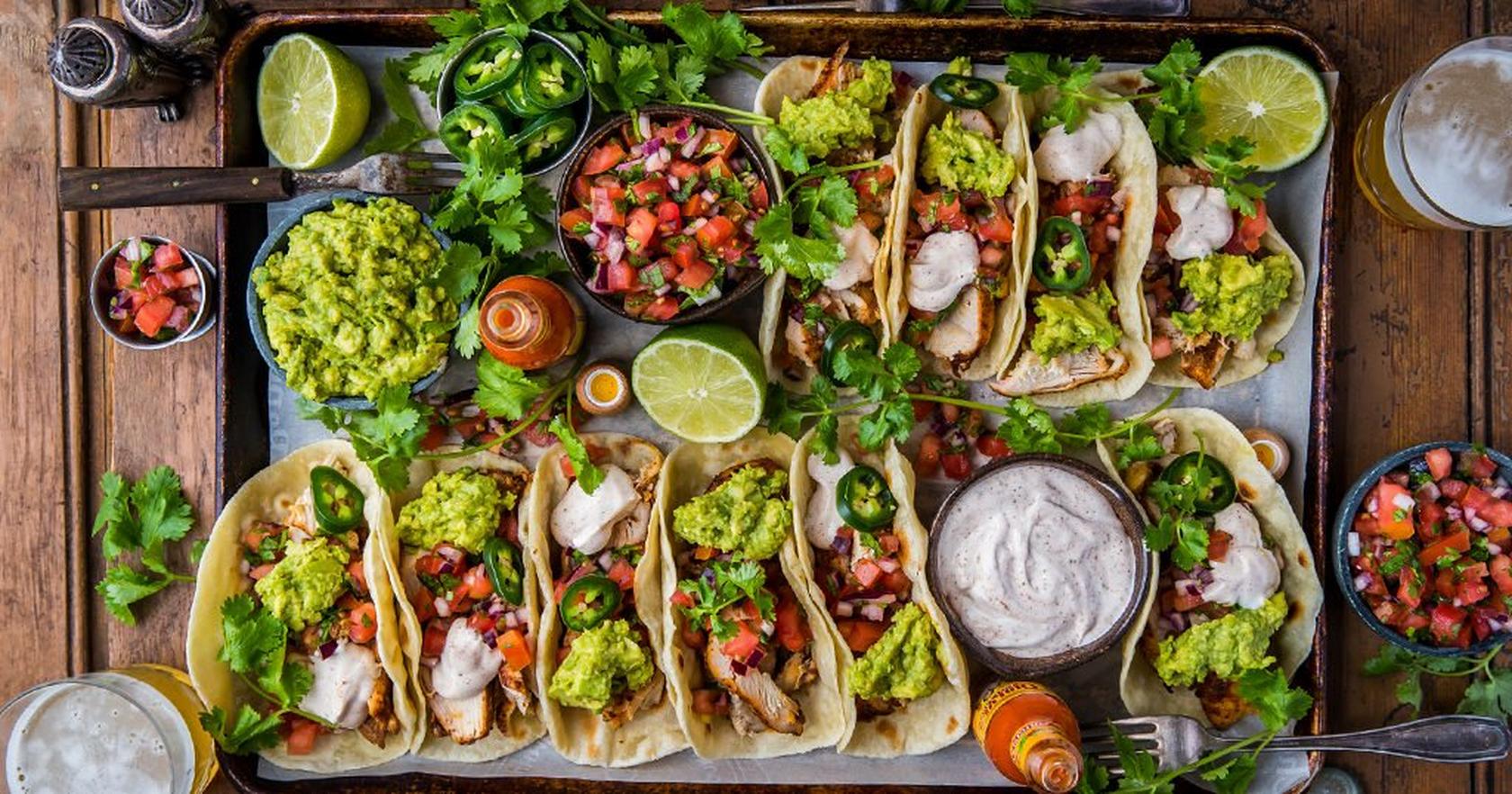
Replace the grilled chicken in this Loaded Grilled Chicken Tacos recipe with your leftover smoked chicken. The recipe has instructions for making fresh pico de gallo, guacamole, and spiked sour cream to serve with the tacos — serve them over warm tortillas or in crispy shells, your call.
4 Ways to Smoke a Whole Chicken
There’s no limit to what you can do to flavor your chicken, but don’t let the options overwhelm you. Here are some basic recipe ideas for getting started:
The Classic Crispy
Smoke Flavor: Alder
Brine: None
Cavity stuffing: None
Rub: Salt, pepper, garlic
Sweet n Spicy
Smoke Flavor: Cherry or mesquite
Brine: Water, apple juice, chopped garlic, onion, carrot, 1 jalapeno or serrano chile pepper, diced without seeds (or with seeds for extra heat)
Cavity stuffing: None
Rub: Traeger Poultry Rub
Smoked Lemon Chicken - Green Version
Smoke Flavor: Maple or oak
Brine: Bay leaves, sprigs of thyme, rosemary, celery, garlic, carrot, and onion
Cavity Stuffing: Fresh quartered lemon or orange, carrot, celery, onion, and garlic
Rub: Garlic and black pepper.
Smoked Lemon Chicken - Red Version
Smoke Flavor: Hickory or oak
Brine: Bay leaves, bell pepper, garlic, thyme and onion
Cavity Stuffing: Fresh quartered lemon or orange, carrot, celery, onion, and garlic
Rub: Cumin, paprika, chili powder, garlic, brown sugar, and black pepper.
You’re off to a good start with any of those ideas, and if you’re on the hunt for more specific flavors, be sure to browse more recipes that show you how to smoke a whole chicken.